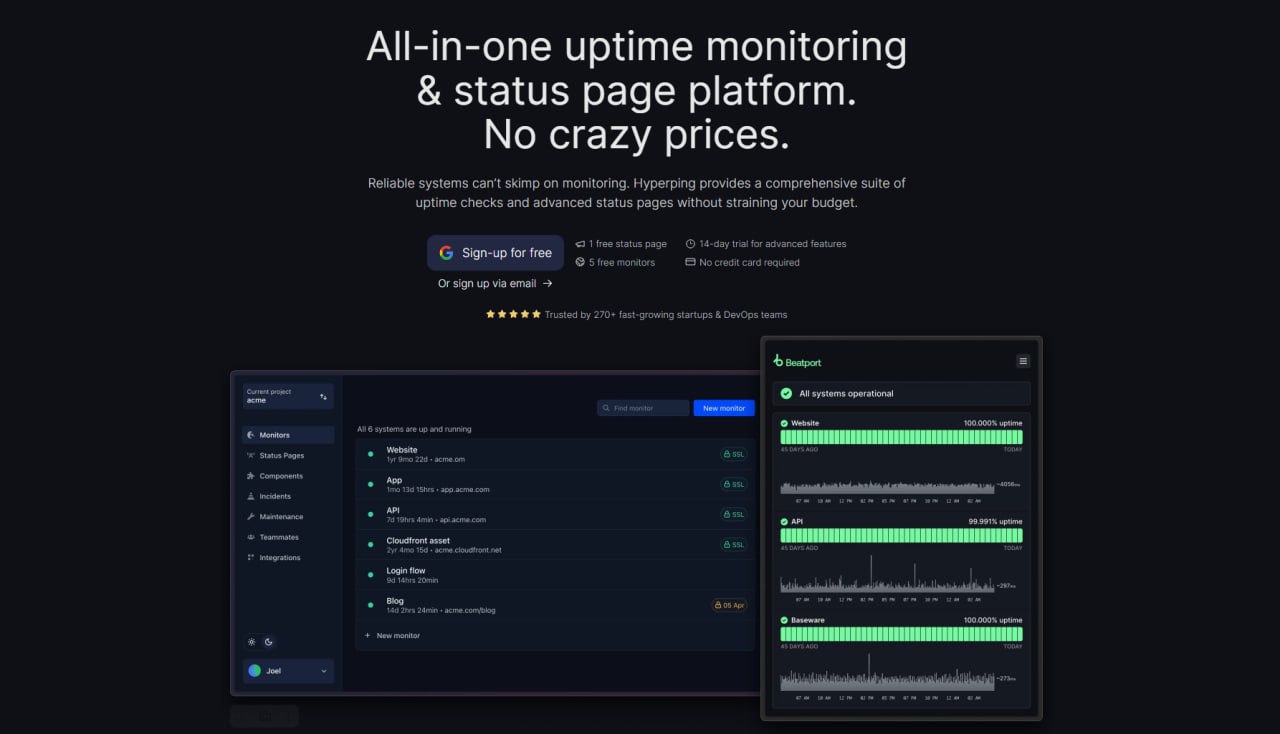From Side Project to a $16K/Month Business: How Leo Built Hyperping
Introduction
When you think about launching a SaaS product, you might believe you need a revolutionary idea. Something no one’s ever done before. But what if you don’t? What if improving what already exists—and doing it better—can lead to success?

Meet Leo, the founder of Hyperping—a service that monitors website uptime and alerts users when things go wrong. In a space crowded with similar tools, launching yet another uptime monitor seemed like a fool’s errand. But Leo didn’t just launch; he thrived, growing Hyperping to 150 paying customers and generating about $16,000/month.
So how did he stand out in a saturated market? The answer lies in simplicity, transparency, and user-driven development.
Why Another Uptime Monitor?
Let’s face it: In 2020, the market for uptime monitoring wasn’t exactly fresh terrain. There were dozens of competitors, from industry giants to indie projects. Why would anyone choose a new product?
The answer is simpler than you’d expect:
🔎 Web infrastructure was evolving. With the rise of microservices and increasingly complex web apps, having a single status page for an entire website no longer cut it. Companies needed clear, reliable ways to monitor multiple services simultaneously.
💡 Leo spotted a gap: While many tools monitored uptime, few focused on making status pages both functional and user-friendly. Hyperping’s solution? A beautiful, customizable status page that non-technical stakeholders could understand at a glance.
🗨️ “It wasn’t about reinventing uptime monitoring—it was about making it accessible and intuitive,” Leo shared in an interview.
Building the MVP: Fast, Focused, and Feedback-Driven
🕒 Time to build: ~1 month (working evenings)
Leo didn’t spend months planning. He built a minimal viable product (MVP) in his spare time. Nights and weekends were enough to get something people could use. And that’s crucial—done is better than perfect.
| Stage | Duration | Focus |
|---|---|---|
| MVP Build | 4 weeks (evenings) | Basic monitoring + status pages |
| Beta Testing | 3 months | Collecting and implementing user feedback |
| Launch (Product Hunt) | 1 day | Public exposure and sign-ups |
🔑 Key insight: Leo didn’t waste time guessing what users wanted—he asked them directly.
🎯 How he gathered feedback:
- Shared progress on Twitter and indie hacker communities.
- Reached out to early users with casual messages like: "Hey, how’s Hyperping working for you? Anything annoying you’d like me to fix?"
- Made himself easily reachable—dropping personal contact details to encourage feedback.
✅ Result: Users didn’t just test—they became invested in improving the product.
Launching on Product Hunt: Small Win, Big Impact
When Hyperping hit Product Hunt, it landed 3rd place for the day. Not a chart-topper, but that didn’t matter—over 1,000 visitors flooded the site, and some converted to paying customers immediately.
| Metric | Result |
|---|---|
| Product Hunt Rank | 3rd place |
| Website Visits | 1,000+ in 24 hours |
| Immediate Conversions | Dozens of paid sign-ups |
🚀 Takeaway: You don’t need to top the charts. Exposure + a solid product = traction.
What Set Hyperping Apart? It’s the Little Things.
Many products have features. Few build trust. Leo knew early on that people buy from people they trust—especially when dealing with something as critical as uptime monitoring.
💬 What he did differently:
- Personalized Support: Leo gave users his direct contact info. Got a question? Message him. He’d reply. Quickly.
- Transparency: Shared milestones, failures, and updates publicly. No corporate-speak—just honesty.
- Iterative Updates: Rolled out small but impactful changes weekly, keeping users engaged.
📝 Why it matters: When users feel heard, they stick around. Hyperping’s churn rate stayed low because people trusted Leo to fix issues and add features they requested.
Revenue Breakdown: How Hyperping Makes $16K/Month
Hyperping’s pricing model was simple, but effective:
| Plan | Price | Features |
|---|---|---|
| Basic | $14/month | Uptime checks + basic status page |
| Pro | $49/month | Advanced monitoring + custom branding |
| Business | $199/month | Team accounts + priority support |
💰 Most customers chose mid-tier or higher plans, and many opted for annual billing discounts—boosting cash flow stability.
📈 Tip: Offering annual plans isn’t just about convenience—it’s about predictable revenue.
Lessons You Can Steal from Leo
- Start before you’re ready. Nights and weekends are enough for an MVP.
- Be present. Don’t hide behind a help desk—human connection sells.
- Iterate with users, not in isolation. Feedback isn’t just data—it’s a roadmap.
- Launch early, learn fast. Product Hunt isn’t the finish line; it’s a feedback engine.
- Keep pricing simple, but valuable. People pay for clarity and convenience.
🗣️ "Most startups overcomplicate things. Just listen, improve, and show up every day. That’s it," Leo says.
Conclusion: The Real Secret? Showing Up.
Hyperping wasn’t a revolutionary idea. Leo didn’t invent uptime monitoring. He just made it friendlier, more transparent, and user-focused. In a sea of competitors, that’s often enough.
This isn’t a story about luck. It’s about consistency, care, and the willingness to talk to users when most founders would rather avoid awkward conversations.
Ready to build your SaaS but not sure where to start?
agency.pizza helps founders validate ideas, craft MVPs, and connect with early users—so you can skip the guesswork.
Let’s turn your side project into something people pay for.






